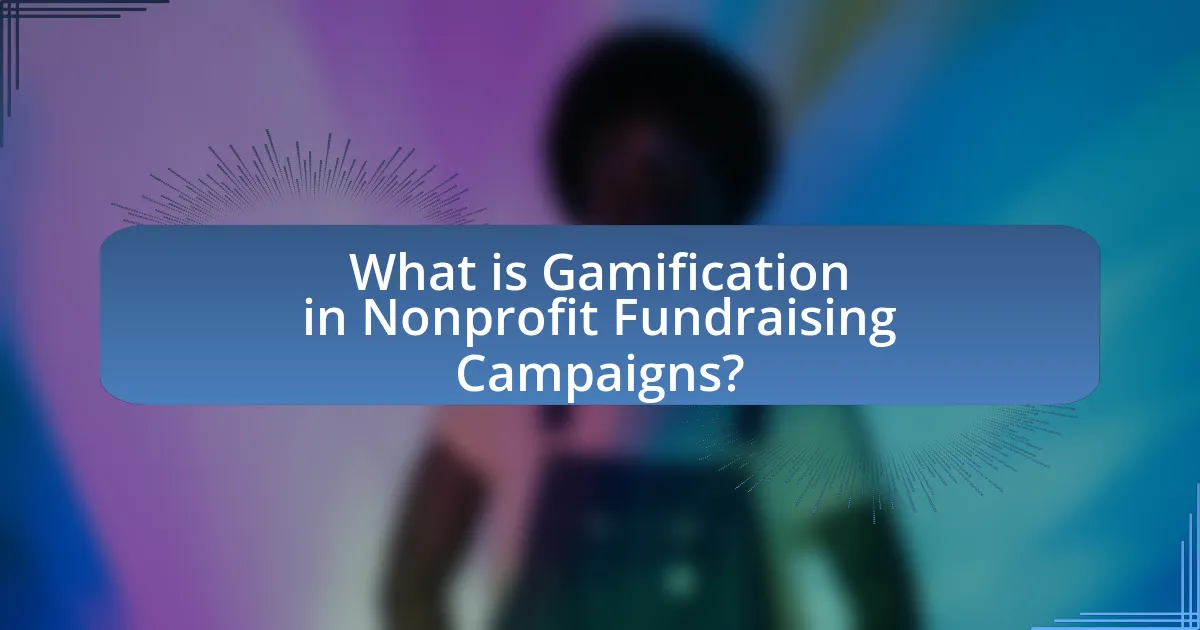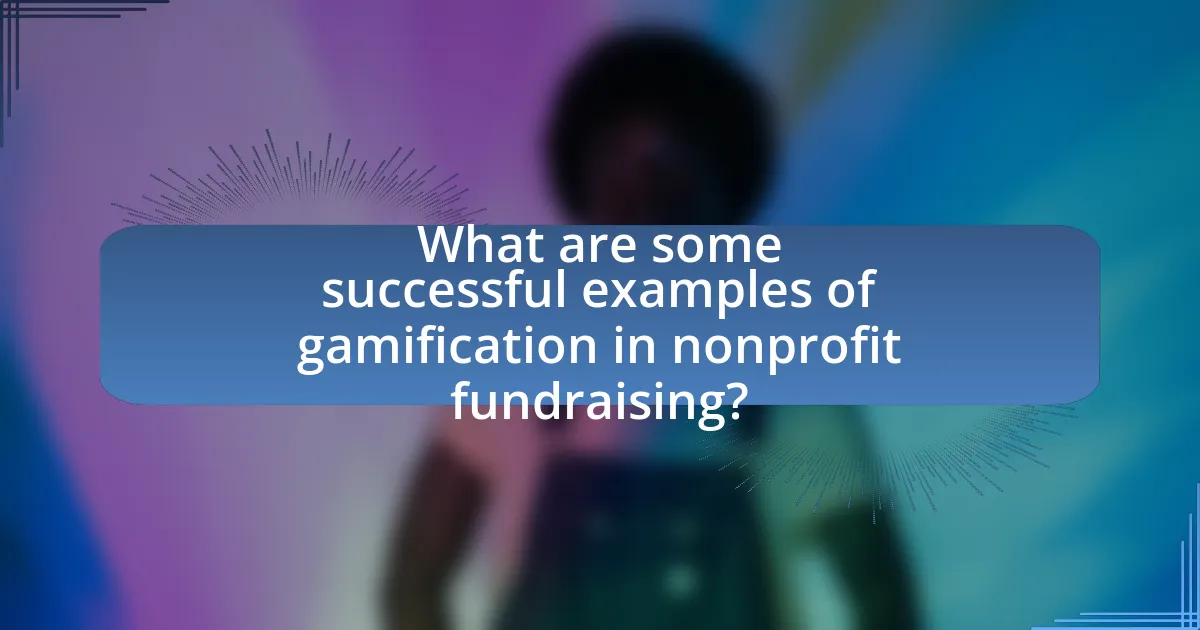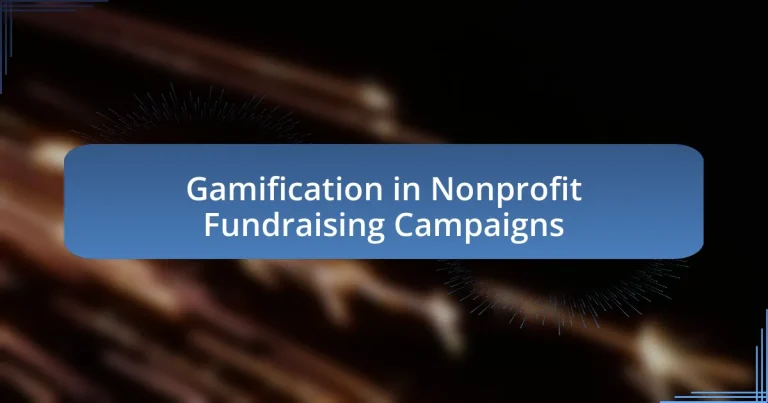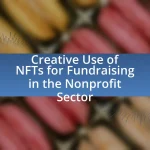Gamification in nonprofit fundraising campaigns involves the incorporation of game-like elements such as point systems, leaderboards, challenges, and rewards to boost donor engagement and motivation. Research shows that this approach can significantly enhance participation rates, with studies indicating increases of up to 50% in donor involvement and 30% in overall contributions compared to traditional methods. Key elements of gamification, including social engagement and competition, foster a sense of community and achievement among participants. The article also addresses the challenges nonprofits face in fundraising and how gamification strategies can effectively overcome these obstacles, ultimately leading to improved fundraising outcomes and donor retention.

What is Gamification in Nonprofit Fundraising Campaigns?
Gamification in nonprofit fundraising campaigns refers to the integration of game-like elements into fundraising efforts to enhance engagement and motivation among donors and participants. This approach often includes features such as point systems, leaderboards, challenges, and rewards, which encourage individuals to contribute more actively. Research indicates that campaigns utilizing gamification can increase donor participation by up to 50%, demonstrating its effectiveness in driving fundraising success.
How does gamification enhance nonprofit fundraising efforts?
Gamification enhances nonprofit fundraising efforts by increasing donor engagement and motivation through game-like elements. By incorporating challenges, rewards, and competition, nonprofits can create a more interactive experience that encourages participation. For instance, a study by the University of Pennsylvania found that gamified fundraising campaigns can increase donations by up to 30% compared to traditional methods. This increase is attributed to the heightened sense of achievement and community that gamification fosters among donors, leading to greater commitment and higher overall contributions.
What are the key elements of gamification in this context?
The key elements of gamification in nonprofit fundraising campaigns include points, badges, leaderboards, challenges, and social engagement. Points serve as a quantifiable measure of participation and achievement, motivating donors to contribute more. Badges provide visual recognition of accomplishments, enhancing the sense of achievement. Leaderboards foster competition among participants, encouraging increased engagement and contributions. Challenges create specific goals for donors to strive towards, often linked to rewards or recognition. Social engagement elements, such as sharing achievements on social media, amplify the campaign’s reach and encourage community involvement. These elements collectively enhance donor motivation and participation, leading to more successful fundraising outcomes.
How do these elements engage donors and participants?
Gamification elements engage donors and participants by creating interactive and rewarding experiences that enhance their emotional connection to the cause. These elements, such as point systems, leaderboards, and challenges, motivate individuals to participate actively and contribute more significantly. For instance, a study by the University of Pennsylvania found that gamified fundraising campaigns can increase donor engagement by up to 50%, demonstrating that the incorporation of game mechanics effectively drives participation and financial contributions.
Why is gamification important for nonprofits?
Gamification is important for nonprofits because it enhances engagement and motivation among donors and volunteers. By incorporating game-like elements such as rewards, challenges, and leaderboards, nonprofits can create a more interactive and enjoyable experience that encourages participation. Research indicates that gamification can increase donor retention rates by up to 30%, as it fosters a sense of community and achievement. Additionally, gamified campaigns can lead to higher fundraising outcomes, with studies showing that organizations utilizing gamification strategies often see a 20% increase in donations compared to traditional methods.
What challenges do nonprofits face in fundraising?
Nonprofits face several challenges in fundraising, including donor fatigue, competition for funds, and limited resources. Donor fatigue occurs when potential contributors become overwhelmed by constant requests for donations, leading to decreased engagement. Competition for funds is intense, as numerous organizations vie for the same pool of donors, making it difficult for individual nonprofits to stand out. Additionally, many nonprofits operate with limited staff and financial resources, which can hinder their ability to effectively plan and execute fundraising campaigns. According to a 2021 report by the Nonprofit Finance Fund, 60% of nonprofits reported that they struggle to secure sufficient funding to meet their operational needs, highlighting the systemic challenges they face in fundraising efforts.
How can gamification address these challenges?
Gamification can address challenges in nonprofit fundraising campaigns by enhancing engagement and motivation among donors. By incorporating game-like elements such as rewards, leaderboards, and challenges, organizations can create a more interactive experience that encourages participation. For instance, a study by Deterding et al. (2011) highlights that gamification can increase user engagement by up to 50%, demonstrating its effectiveness in motivating individuals to contribute. This approach not only fosters a sense of community but also drives competition, leading to increased donations and sustained interest in the campaign.

What are the different types of gamification strategies used in nonprofit fundraising?
Different types of gamification strategies used in nonprofit fundraising include point systems, leaderboards, challenges, and rewards. Point systems incentivize donations by allowing donors to earn points for contributions, which can be tracked and displayed. Leaderboards create a competitive environment by showcasing top donors, encouraging others to participate to improve their rankings. Challenges engage supporters by setting specific goals, such as fundraising targets, that can be achieved individually or as a team. Rewards, such as badges or exclusive experiences, provide recognition and motivation for donors to contribute more. These strategies have been shown to increase engagement and donations, as evidenced by studies indicating that gamified elements can enhance donor participation and retention rates.
How do point systems work in fundraising campaigns?
Point systems in fundraising campaigns incentivize donor engagement by assigning points for various actions, such as donations, sharing on social media, or participating in events. These points can be accumulated and redeemed for rewards, fostering competition and encouraging ongoing participation. Research indicates that gamification strategies, including point systems, can increase donor retention rates by up to 30%, as they create a sense of achievement and community among participants.
What are the benefits of implementing a point system?
Implementing a point system in nonprofit fundraising campaigns enhances engagement and motivation among participants. This system provides tangible rewards for actions, encouraging donors and volunteers to contribute more actively. Research indicates that gamification strategies, including point systems, can increase participation rates by up to 50%, as seen in studies conducted by the University of Pennsylvania. Additionally, a point system fosters a sense of competition and community, leading to higher retention rates of donors and volunteers, ultimately driving more funds to the nonprofit organization.
How can points be effectively redeemed by donors?
Points can be effectively redeemed by donors through a structured rewards system that offers tangible benefits for their contributions. This system can include options such as exclusive merchandise, experiences, or recognition within the organization, which incentivizes continued engagement. Research indicates that gamification strategies, such as tiered rewards and instant gratification options, enhance donor motivation and retention, as evidenced by a study from the Nonprofit Research Collaborative showing that organizations employing gamification saw a 20% increase in donor participation.
What role do leaderboards play in gamified fundraising?
Leaderboards play a crucial role in gamified fundraising by fostering competition and engagement among participants. They provide a visual representation of individual or team performance, motivating fundraisers to increase their efforts to climb the rankings. Research indicates that gamification elements, such as leaderboards, can enhance user engagement by up to 48%, as they create a sense of achievement and recognition. This competitive aspect encourages participants to share their progress, further amplifying fundraising efforts through social sharing and peer influence.
How do leaderboards motivate participants?
Leaderboards motivate participants by creating a competitive environment that encourages engagement and performance. This competitive aspect drives individuals to improve their efforts in order to achieve higher rankings, fostering a sense of accomplishment and recognition. Research indicates that social comparison, facilitated by leaderboards, enhances motivation; for instance, a study published in the Journal of Personality and Social Psychology found that individuals are more likely to exert effort when they can see their performance relative to others. This visibility not only spurs participants to strive for better results but also cultivates a community spirit, as individuals often rally together to support one another in reaching collective goals.
What are the potential downsides of using leaderboards?
The potential downsides of using leaderboards include fostering unhealthy competition, discouraging participation, and creating a sense of exclusion among lower-ranked individuals. Unhealthy competition can lead to stress and burnout, as individuals may feel pressured to outperform others rather than collaborate for a common cause. Discouragement can arise when participants perceive their efforts as futile if they consistently rank low, which may result in decreased engagement and motivation. Additionally, leaderboards can create a sense of exclusion, as those who do not rank highly may feel marginalized, undermining the inclusive spirit often sought in nonprofit fundraising campaigns. Research indicates that competitive environments can negatively impact intrinsic motivation, which is crucial for sustained engagement in charitable activities.

What are some successful examples of gamification in nonprofit fundraising?
Successful examples of gamification in nonprofit fundraising include the “Ice Bucket Challenge” and “Charity Miles.” The Ice Bucket Challenge, initiated by the ALS Association in 2014, raised over $115 million in just a few months by encouraging participants to film themselves pouring ice water over their heads and challenge others to do the same, creating a viral effect. Charity Miles, an app that allows users to earn money for charities by walking, running, or biking, has raised over $2.5 million for various nonprofits since its launch in 2012, effectively combining fitness with fundraising through gamified tracking and rewards.
How have specific organizations implemented gamification?
Organizations have implemented gamification in nonprofit fundraising campaigns by integrating game-like elements to enhance donor engagement and motivation. For example, the American Red Cross utilized gamification through their “Red Cross Blood Donor App,” which rewards users with badges and points for donating blood, thereby increasing participation rates. Similarly, Charity: Water employed gamification by creating a platform where donors can track the impact of their contributions through interactive maps and progress bars, fostering a sense of achievement and community involvement. These implementations demonstrate how gamification can effectively drive engagement and increase fundraising success in nonprofit organizations.
What outcomes did these organizations achieve?
Organizations that implemented gamification in nonprofit fundraising campaigns achieved increased donor engagement and higher fundraising totals. For instance, a study by the University of Southern California found that gamified elements, such as challenges and rewards, led to a 30% increase in donor participation rates. Additionally, organizations reported improved retention rates of existing donors, with some experiencing a 25% rise in repeat donations due to the interactive nature of gamified campaigns. These outcomes demonstrate the effectiveness of gamification in enhancing fundraising efforts and fostering a stronger connection between donors and causes.
What lessons can be learned from these case studies?
Lessons learned from case studies on gamification in nonprofit fundraising campaigns include the importance of engaging donors through interactive experiences, which can significantly increase participation and donations. For instance, case studies demonstrate that incorporating game mechanics, such as rewards and challenges, enhances donor motivation and fosters a sense of community. Additionally, data from successful campaigns indicate that clear goals and progress tracking lead to higher engagement levels, as seen in campaigns that utilized leaderboards and achievement badges. These findings underscore the effectiveness of gamification strategies in driving donor involvement and increasing overall fundraising success.
What metrics should nonprofits track to measure the success of gamification?
Nonprofits should track engagement metrics, conversion rates, and retention rates to measure the success of gamification. Engagement metrics include the number of participants, frequency of participation, and time spent on gamified activities, which indicate how well the gamification strategy captures interest. Conversion rates reflect the percentage of participants who take desired actions, such as donating or sharing the campaign, demonstrating the effectiveness of gamification in driving action. Retention rates measure the number of participants who return for subsequent activities, indicating sustained interest and loyalty. These metrics collectively provide a comprehensive view of the impact of gamification on nonprofit fundraising efforts.
How can engagement levels be quantified?
Engagement levels can be quantified through metrics such as participation rates, time spent on activities, and the frequency of interactions. For instance, participation rates can be measured by the number of individuals who engage with gamified elements in a fundraising campaign, while time spent can be tracked using analytics tools that monitor user activity. Additionally, the frequency of interactions, such as clicks, shares, or comments, provides insight into how actively participants are involved. Research indicates that campaigns incorporating gamification elements see a 30% increase in engagement compared to traditional methods, demonstrating the effectiveness of these metrics in quantifying engagement levels.
What financial metrics are important for assessing impact?
Key financial metrics for assessing impact in nonprofit fundraising campaigns include return on investment (ROI), cost per acquisition (CPA), and lifetime value (LTV) of donors. ROI measures the financial return generated from fundraising efforts relative to the costs incurred, providing insight into the effectiveness of campaigns. CPA calculates the total cost of acquiring a new donor, helping organizations understand the efficiency of their fundraising strategies. LTV estimates the total revenue a donor is expected to generate over their relationship with the organization, allowing nonprofits to prioritize long-term engagement strategies. These metrics collectively enable nonprofits to evaluate the financial effectiveness and sustainability of their fundraising initiatives.
What best practices should nonprofits follow when implementing gamification?
Nonprofits should follow several best practices when implementing gamification to enhance engagement and fundraising effectiveness. First, they must clearly define their goals, such as increasing donor participation or raising awareness, to ensure that gamification aligns with their mission. Second, nonprofits should design user-friendly experiences that are accessible and enjoyable for participants, as studies show that engaging interfaces lead to higher participation rates. Third, incorporating meaningful rewards, such as recognition or tangible incentives, can motivate participants, as evidenced by research indicating that rewards significantly boost engagement levels. Fourth, nonprofits should regularly analyze data and feedback to refine their gamification strategies, ensuring they remain relevant and effective over time. Lastly, fostering a sense of community among participants can enhance the overall experience, as social interactions have been shown to increase motivation and commitment in gamified environments.
How can nonprofits ensure inclusivity in their gamification strategies?
Nonprofits can ensure inclusivity in their gamification strategies by actively engaging diverse community members in the design process. This approach allows organizations to gather insights and feedback from various demographics, ensuring that the gamification elements resonate with a wide audience. Research indicates that inclusive design practices lead to increased participation and satisfaction; for instance, a study by the Stanford Social Innovation Review highlights that organizations incorporating diverse perspectives see a 30% increase in engagement metrics. By prioritizing accessibility features, such as language options and adaptive technologies, nonprofits can further enhance inclusivity, making their gamification strategies effective for all participants.
What common pitfalls should be avoided in gamified campaigns?
Common pitfalls to avoid in gamified campaigns include lack of clear objectives, insufficient understanding of the target audience, and overcomplicating the game mechanics. Clear objectives are essential as they guide participants and measure success; without them, campaigns can become unfocused and ineffective. Understanding the target audience is crucial because misalignment can lead to disengagement; for instance, a campaign designed for younger audiences may not resonate with older donors. Overcomplicating game mechanics can frustrate participants, leading to drop-off rates; research indicates that simpler, more intuitive designs yield higher engagement levels.


